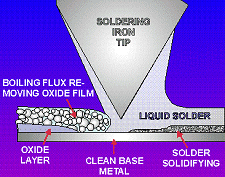Ariel Eisenhandler, Israel Astronomical Society

The operation of the resin, from "Practice Series in Electrical Engineering"
Direct link to this page: https://www.hayadan.org.il/iss260804.html
There is nothing routine about working in space, as astronaut Mike Fincke recently discovered when he was soldering aboard the International Space Station (ISS).
Richard Grugel, a materials scientist at the Marshall Space Flight Center, watched his video monitor in disbelief. The monitor showed a transmitter from the International Space Station.

Astronaut Mike Fink touches a tin-wrapped metal wire with the tip of a soldering iron. NASA.
Watch the full video: Windows Media Format (2MB)
The heated tin turned into a molten bubble with drops of resin stuck to the outside. Die-hard tin: This is not particularly surprising. The behavior of the resin is what is surprising. As the temperature rose, the drip began to spin in circles, gaining speed, like a miniature merry-go-round.
"What a surprise," said Grugel, "I've never seen anything like this."
Grogel is the senior researcher of the "In-Space Soldering Investigation (ISSI), something that astronaut Fink was engaged in at the time of the discovery. The purpose of the ISSI is to find out how tin, or any other solder metal, behaves in a weightless environment. This is very important information for astronauts. If something breaks during a long journey to Mars, they will probably need tin or some other soldering metal to fix the problem.
Author's Note: The ISSI is not the first experiment to test soldering in zero gravity conditions. For more information - Gravitational Effects on Solder Joints.
The solder used by Fink for the ISSI mission is a mixture of lead, tin and resin. The purpose of the lead and lead is to make a conductive electrical connection. So why the resin?
Grogel explains: "When metals are exposed to air, they are covered in oxide." Iron, for example, rusts: iron oxide. "One purpose of the resin is to clean the oxide before the lead and tin crystallize, thus paving the way for a strong and good bond between the two."
burn another target. On the surface and in space the surface tension has a tendency to hold the tin in the form of strange drops. The resin breaks the surface tension, an action called "wetting", and allows the molten tin to flow.
But as you can see in the video, weightless resin doesn't behave as expected all the time. Is this a problem?
To find out if it is or not, Grogel plans to cut open the tin drops that Pink created and check what's inside. He will have the opportunity to examine whether the tin made good and clean contact with the metal wire. It will also look for tiny droplets of vaporized resin within the droplets; Bubbles like these, which also appear in the solder joints on the DHA, reduce the electrical and thermal conductivity of the joint.
The samples will be returned to Earth by an astronaut in a Soyuz capsule or, perhaps, after the space shuttle launch program is restarted. No date yet.
Meanwhile Grogel and his colleagues are brainstorming to figure out what makes the resin spin. "We almost found why," Grogel says, but is not ready to announce a solution yet. Anyway, he has some advice for astronauts with a knack for soldering: wear your goggles and watch out for flying resin.
For information on the NASA website
Yadan International Space Station
https://www.hayadan.org.il/BuildaGate4/general2/data_card.php?Cat=~~~933687687~~~88&SiteName=hayadan
